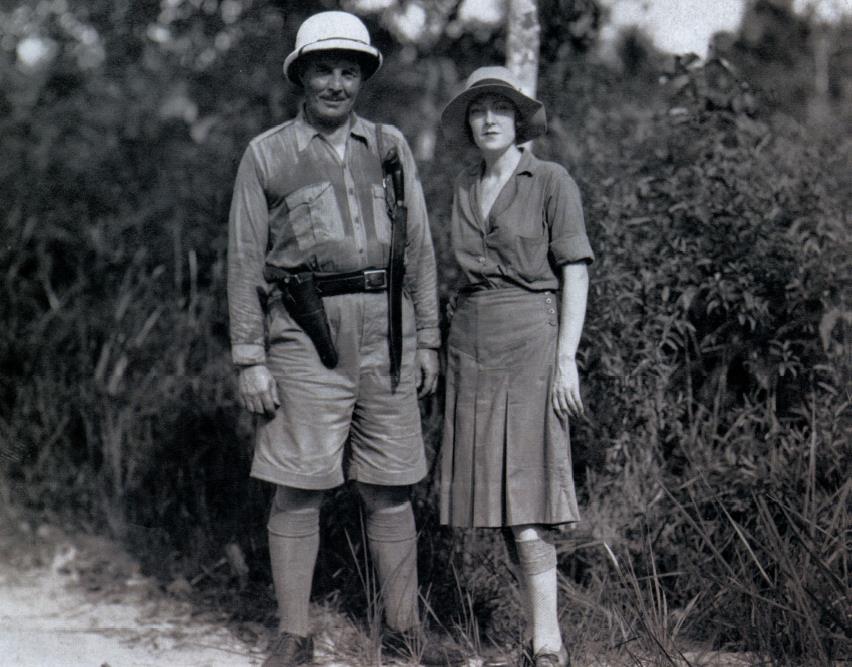
Frank Buck with his
wife, Muriel. Their
daughter, Barbara,
says Buck “loved life
more than anyone
I’ve ever known.”
Perhaps no native son of Texas ever claimed a more globetrotting sense of adventure than Frank Buck (1884-1950). This international hunter, author, and filmmaker was born in Gainesville, Texas, and as an adult traveled to the jungles of South America, Indonesia, Malaysia, India, and Africa, capturing and bringing back animals for zoos, circuses, and private collections. His success earned him the nickname Frank ”Bring ‘Em Back Alive” Buck.
Buck moved from Gainesville to Dallas when he was six and then, as a teenager, lived at a ranch near San Angelo.
Fittingly for a native Texan, Buck started out as a cowboy. He worked on area ranches learning the trade, and at 18, was hired to oversee a trainload of cattle headed to Chicago. Winnings from a poker game in 1911 financed a trip to Brazil, where he exported parrots for profit This experience influenced his decision to deal in exotic animals on a large scale. Soon, he was making a living selling animals to zoos and circuses in North America and Europe. By 1930, Buck had traveled extensively and collected enough tales to write his best-selling book, Bring ‘Em Back Alive. He followed up that popular title with others such as Wild Cargo (1932), Fang and Claw (1935), and his autobiography, All in a Lifetime (1941).
Buck contributed to The Saturday Evening Post and Collier’s in the ’20s and ’30s, in addition to hosting a network radio program. He appeared as a celebrity guest on numerous radio shows, and ultimately produced and starred in movies. Audiences found his tales of near-death encounters
with animals in the wild to be thrilling. Buck’s 1932 movie Bring Em’ Back Alive, became one of the year’s biggest hits, establishing an audience for additional motion-picture productions: Wild Cargo, Fang and Claw, Jungle Menace, Jacare, and Tiger Fangs. Reportedly, Buck was the model for the character of film director Carl Denham (portrayed by actor Robert Armstrong) in the original movie King Kong. Buck’s box-office appeal also landed him
a starring role with Abbott and Costello in the comedy Africa Screams.
In 1934, Buck turned his immensely popular 1933 Chicago World’s Fair exhibit (a replica of his overseas jungle base camp) into an East Coast attraction—a 40-acre zoo and base camp on Long Island, called Frank Buck’s Jungle Camp. Buck had his staff grow mustaches and wear the same khaki outfit he
did. Employees also carried autographed Frank Buck cards, so that when visitors came up and asked “Frank Buck” for an autograph, the employee just handed them a card. Nancy Jane Tetzlaff, whose first husband, Larry, left college to work with reptiles at Buck’s Long Island operation says, “No one knew exactly what Buck looked like except for this image of him in a pith helmet.”
Tetzlaff reports that Buck took Larry aside and told him, ”Young man, always remember, no matter how rare the animal is, unless there is a lot of animation
it doesn’t matter. People will always be attracted to activity.” Buck noticed people had more fun watching rhesus monkeys than a rare Indian rhino he had captured, she added.
Several unforeseen circumstances proved problematic. During World War II, the Japanese took over the Singapore hotel that Buck used as his base for animal-capture forays, according to his daughter, Barbara. Gas rationing meant fewer people could drive to see the Jungle Camp, and there were problems getting food for the animals, recounted Buck’s Jungle Camp partner, T.A. Loveland. Buck eventually left that venture, and by 1946 had moved to be with family in San Angelo. He planned a return excursion to Malaysia and ordered lassos made in San Angelo for the trip-but died of lung cancer in 1950.
Today, staff members at the Frank Buck Zoo in Gainesville field questions about this adventurous raconteur, and keep this famous Texan’s story alive. The zoo started with animals from the Gainesville circus after it disbanded in the 1950s and was renamed in honor of Buck in 1954.
“One of the biggest misconceptions for people who have heard of Buck is that he just went out and captured animals for zoos,” says zoo director Susan Kleven. Buck’s daughter, Barbara, agrees that her father saw wild animals as more than potential exhibits. ”Way back before people said, ‘Oh, there’s not going to be any more; he realized how limited the future was for many of these animals.”
The value of providing animals naturalistic habitats in which to flourish was not a particularly common consideration in Frank Buck’s era. But, Buck believed people should have the opportunity to view, and would thoroughly enjoy, rare and exotic species in person- especially if the creatures were well cared for. Before Mutual of Omaha’s Wild Kingdom with Marlin Perkins, Jane Goodall, Animal Planet, the San Diego Zoo’s Joan Embery, Jim Fowler, Crocodile Hunter Steve Irwin, The Lion King, and The Discovery Channel, Buck’s life work shaped a legacy of zoological education.








